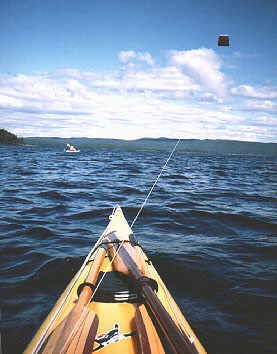by Sandy Richardson
Parafoil kites are great toys and make wonderful sails for kayaks. Wind fills the open cells in the kite, creating a wing that gives remarkable pulling power. When not in use, the kite, made entirely of fabric, fits neatly into a small stuff sack that, along with the string and winder, fits neatly under the kayak’s deck lines.
Compared to other sailing rigs, a kite is easier to stow, easier to deploy and, without a mast, the risk of capsize is reduced.
The best size parafoil to use as a sail for a single kayak is probably a J-10. It gives good pull, and is still relatively easy to launch. A J-15 would probably be best for a double, though I’ve never tried.
You also need line and a winder. Strong 100-200 lb. test line is best. The heavier line tangles less and keeps the kite flying at a lower angle. I use one of the large winders with offset handles at each end. This makes it easy to bring the kite in quickly, and the handles also make it easy to secure under the deck lines while sailing.
Since the wind must keep the kite up as well as pull the kayak, you need a wind of about 10 knots at least. My rule of thumb is that there must be white caps before there is enough wind for kite sailing.
The hardest part of kite sailing is launching the kite, due to the turbulent air near the water surface and your low and restricted position in the cockpit. Hold the sides of the kite so that the wind fills the cells. Then, when the kite starts to lift, give it a little toss upwards and grab the line so that you can get tension on it, and hence control, as quickly as possible. I usually hold the line in my teeth so I can find it quickly. Keeping the kayak broadside to the wind and launching sideways is sometimes easier than launching while moving straight downwind. The stronger the wind, the easier it is to launch the kite.
While all this seems awkward at first, with a little practice it becomes relatively easy.

Once the kite is up, let out line until it flies smoothly. The higher the kite flies, the more it will tend to lift the kayak rather than pull it forward; whereas the lower it flies the more of its pull will go into moving the kayak forward. Generally, the lower you can get the kite to fly smoothly the faster you will go. The stronger the wind, the shorter the line you need.
I don’t use a tail on the kite while sailing and have never needed one. A tail will make launching harder as it tends to stick in the water.
You will, of course, need a rudder to steer your boat while sailing. (Surely this gives the definitive answer to the old “rudder-versus-no-rudder” question: You need one so that you can kite sail. Enough said.) You can easily sail up to about 45o off the direction of the wind.
While sailing you can either hold the winder in your hands or secure it under your deck lines. (Make sure it is well secured. I lost one kite when it came loose from the deck lines. With the weight of the winder it just kept going until it hit shore and got trapped in the treetops where sadly it remains.) Securing the line to the boat in this way lets you use your hands for other things like snacking, taking pictures or bracing if you need extra stability in waves. In really big wind and waves I have used my paddle in a running brace as a sort of outrigger.
It’s probably a good idea to keep a knife handy so that you can cut the line in case you get into difficulty. And if you are sailing alone you may want a tether between you and your boat in case of capsize. It’s hard to catch up to a capsized kayak in a wind, let alone one being towed by a kite.
That’s it. Once the kite is up you just sit back, use your feet to steer and enjoy the free ride. You will go about as fast as you would paddling at a moderate rate.
Give it a try; it’s fun. And may the wind always be at your stern.
